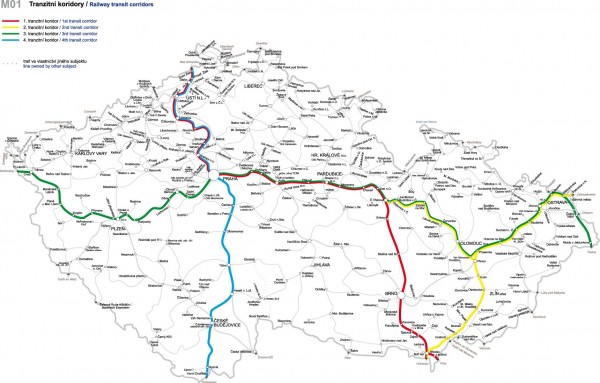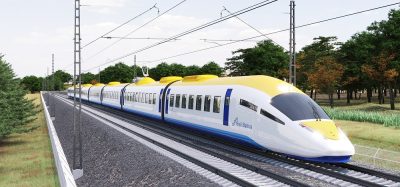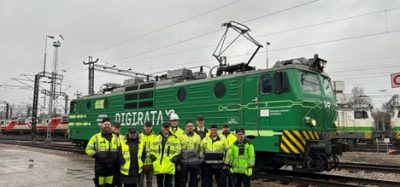High quality railway infrastructure should lead to increased competition
Posted: 31 May 2010 | | No comments yet
SŽDC, the Czech Railway Infrastructure Administration, is responsible for the modernisation and development of the railway network in the Czech Republic. We put great effort into enhancing the quality of our railway infrastructure and, together with carriers, we offer reliable services to both passengers and freight transport.
In my opinion, if the European railways do not establish a top-quality and reliable network in the near future, and do not provide customers with high-quality services with the assistance of carriers, then their future might be seriously endangered.
SŽDC, the Czech Railway Infrastructure Administration, is responsible for the modernisation and development of the railway network in the Czech Republic. We put great effort into enhancing the quality of our railway infrastructure and, together with carriers, we offer reliable services to both passengers and freight transport. In my opinion, if the European railways do not establish a top-quality and reliable network in the near future, and do not provide customers with high-quality services with the assistance of carriers, then their future might be seriously endangered.
SŽDC, the Czech Railway Infrastructure Administration, is responsible for the modernisation and development of the railway network in the Czech Republic. We put great effort into enhancing the quality of our railway infrastructure and, together with carriers, we offer reliable services to both passengers and freight transport.
In my opinion, if the European railways do not establish a top-quality and reliable network in the near future, and do not provide customers with high-quality services with the assistance of carriers, then their future might be seriously endangered.
SŽDC is trying to integrate the backbone lines of the Czech Railways into the trans- European corridors and to build them in line with the adopted principles of interoperability so that they can be used by national carriers as well as by foreign companies.
SŽDC guarantees equal access to all carriers who meet the conditions – i.e. those specified by the European Directive 2001/14, implemented in the Czech Law 266/94 Coll. on the amended Railway Act. Since 2003, SŽDC has been allocating the path capacity and since 2004 it has been issuing the Network Statement specifying track access conditions and defining track access charges (in compliance with the European Directive 2001/14). The Network Statement is released annually (in Czech and English) in a uniform structure approved by European railways associated in the RailNet Europe (RNE) organisation. Since 2008, SŽDC has been developing timetables which, up until then, had been produced by the Czech Railways. Over 60 carriers operate on the railway infrastructure of the Czech Republic – not all of them are from the Czech Republic – but Czech Railways does have the highest transport share.
The railway network in the Czech Republic
The railway network in the Czech Republic is one of the densest in Europe – with over 9,400km of tracks, of which more than 32% are electrified (AC and DC traction system) and there are approximately 8,500 level crossings and a large number of artificial structures. For more details, see Table 1.
Table 1
| Indicator | Number |
| Length of lines total | 9 487 km |
| Length of electrified lines | 3 078km |
| Length of standard-gauge lines | 9 464km |
| Length of narrow-gauge lines | 23km |
| Length of single lines | 7 580km |
| Length of double and multiple lines | 1 907km |
| Constructional length of lines total | 15 616km |
| Number of switch units | 25 327km |
| Bridges | 6 715km |
| Tunnels | 158km |
| Total length of bridges | 149 399km |
| Total length of tunnels | 42 927km |
Railway Infrastructure Administration, state organisation
SŽDC was established by law in 2003, but 2008 was a crucial year in terms of realising SŽDC’s function. Czech Railways, joint-stock company assumed the operator’s function of national and regional rail owned by the state and related material, technological and personnel capacities. The number of staff increased from approximately 500 to 10,000 employees.
This reform furthered the enhancement of the infrastructure manager function at SŽDC, as defined by European directives. Since then, SŽDC has been providing infrastructure operability with its own capacities. Work associated with rail service is contractually provided by the Czech Railways, joint-stock company for SŽDC, which means that the train dispatcher control is currently performed by ČD. Anticipated changes would lead to another step to create equal conditions for all carriers, and they would enhance the transparency of the railway system and to finally increase the efficiency of the railway as a whole. For more details, see Table 2 on page 62.
Modernisation of the Czech Railway network
SŽDC ensures the operation and operability of the railway infrastructure along all lines owned by the state, with the exception of those on which the rail operation was previously decided to be interrupted. We are pleased to say that nowadays our organisation can fully focus on these activities which also include the modernisation and development of the railway infrastructure. In this field we have defined the following priorities:
- Modernisation of railway transit corridors including crucial railway junctions
- Enhancement of safety at level crossings
- Electrification of other tracks
- Implementation of GSM-R and ETCS systems and ensuring the interoperability of tracks included in the European railway system
- Rationalisation actions (e.g. long-distance track control)
- Reconstruction of other tracks
- Construction of new train stops, shelters and platforms
History
In the 1990s, the Czech Government adopted the resolution on the modernisation of the First Railway Transit Corridor (TŽK). This was the start of an era of corridor line modernisation projects in the Czech Republic. The construction of the Second TŽK followed. At present, these two corridors have been completed and the third and fourth TŽK are underway (see Figure 1 on page 62).
For nearly 20 years, the modernisation and optimisation of the railway corridors in the Czech Republic has been progressing. We consider this to be the biggest railway event and biggest investment within the railway infrastructure for the last 100 years.
Main purpose
The purpose of the corridors construction is as follows:
- To link the main routes with the most significant European railway lines in order to maintain and to possibly enhance the volume of international transport
- To offer a high-quality and comfortable infrastructure, which will allow the reduction of travelling times and:
- To equip lines with a technological device that can ensure operational lines speeds of up to 160km/h
- To enhance the line speed up to 160km/h inclusive on sufficiently long sections in order to effectively use the enhanced speed
- To ensure the track loading class of D4 UIC for the line speed of 120km/h inclusive
- To implement the clear space in compliance with the loading gauge of UIC GC and broader vehicles
- To ensure the requested track capacity
- To enhance the safety of passengers by building new island platforms (platform edge of 550mm over the top of rail) and pedestrian subways equipped with barrierfree access for disabled people, acoustic beacons for the visually impaired etc.
- To enhance railway operational safety
- To reduce the noise level by building noise barriers and applying elastic rail fastening (anti-vibration measure) in compliance with the sanitary standards
The principles of track modernisation in the Czech Republic follow the agreements on the European Railway Network AGC, AGTC as well as the guidelines of the European Union Council for the development of the trans- European transport network.


Figure 1 Map of Railway Transit Corridors (TŽK). 1. TŽK: Germany – Děčín, Prague, Česká Třebová, Brno, Břeclav – Austria (E 55, E 40, E 61) 2. TŽK: Austria – Břeclav, Přerov, Ostrava, Petrovice u Karviné – Poland (E 65) with the branch line Česká Třebová-Přerov (E 40) 3. TŽK: Slovakia – Mosty u Jablunkova, Dětmarovice, Přerov, Česká Třebová, Prague, Pilsen, Cheb – Germany (E 40) 4. TŽK: Germany – Děčín, Prague, Veselí nad Lužnicí, České Budějovice, Horní Dvořiště – Austria (E 55)
Main lines
The following trans-European main railway lines run through the Czech Republic:
- C-E 40: Le Havre–Paris–Forbach–Frankfurt (M) –Schirnding–Cheb–Pilsen–Prague– Olomouc–Hranice na M. –Ostrava/ Púchov–Žilina–Košice–Čierna n/T–Lvov
- C-E 55: Stockholm–Trelleborg– Sassnitz Hafen–Berlin/Seddin– Bad Schandau–Děčín–Prague– Horní Dvořiště–Linz–Salzburg–Villach– Tarvisio–Venezia–Bologna/Trieste
- C-E 551: Prague–Horní Dvořiště–Linz– Selzthal–St. Michael
- C 59: Swinoujscie–Szczecin–Wroclaw– Miedzylesie–Lichkov–Česká Třebová
- C-E 61: Stockholm–Trelleborg– Sassnitz Hafen–Berlin/Seddin–Bad Schandau–Děčín–Nymburk–Havlíčkův Brod–Brno–Břeclav–Bratislava– Komárom/Hegyeshalom–Budapest
- C-E 65: Gdynia–Gdaňsk–Warszawa– Katowice–Petrovice u Karviné–Ostrava– Přerov–Břeclav–Wien–Bruck a.d. Mur–Villach–Jesenice–Ljubljana–Rijeka
- C 65: Nowa Sol–Wegliniec–Zawidow– Frýdlant v Č.–Liberec–Turnov–Prague
Table 2
| • SŽDC, s.o. Prague Headquarters |
| • 13 Regional Infrastructure Administrations in regional cities |
| • 3 Civil Engineering Administrations (Prague, Pilsen, Olomouc) |
| • 2 Railway Geodesy Administrations (Prague, Olomouc) |
| • Railway Energy Administration (Hradec Králové) |
| • Technical Centre of Infrastructure (Prague) |
| • Fire Department (Prague and 18 units all over the rail network) |
Main railway junctions
In addition to the modernisation of the railway transit corridors, work is currently being performed to modernise crucial railway junctions. The purpose of their modernisation is to ensure the same technical parameters of the previously completed and connected corridor lines. The railway junctions Děčín, Ústí nad Labem, Kolín and Choceň a Bohumín are completed; Břeclav and Přerov and the 1st phase of the Brno railway station are being built. The modernisation of the western part of Prague central station has also been completed and the ‘New Link’ between Prague central station, Prague Libeň, Prague Masarykovo station and Prague Vysočany has been put into operation. These two constructions are to allow for better transit through the whole railway junction of Prague for trains and they also help to facilitate the traffic situation in our capital and on our roads (by extending communications under bridges and thus enhancing the capacity of adjacent crossings, eliminating level crossings and avoiding unpleasant waiting at gates, enhancing safety by building flyovers etc.).
Projects for the modernisation of other railway stations are being prepared; including Pilsen, Pardubice, Ústí nad Orlicí, Česká Třebová and Olomouc. The modernisation of the line between Prague and Kladno linked with Ruzyně airport is being prepared – it will ensure fast and capacity-attractive transportation between Prague and the Kladno conurbation as well as railway connections to the international airport Prague Ruzyně.
ERTMS/ ETCS: providing interoperability
SŽDC considers international cooperation as one of its most significant functions because it is well-aware of the fact that separate railway companies could never stand the test by European transport standards. The Czech Republic, as a member of the European Union, committed itself to build interoperable corridors with a view to interlinking our lines with international routes of European significance.
SŽDC is heading the all-European Management Committee for implementation of ETCS (European Train Control System) on Corridor E, i.e. in the section Dresden–Děčín–Prague–Bratislava/Vienna–Bud apest–Bucharest–Constanta. It coordinates the implementation of ERTMS/ETCS systems in the member states. On the Czech territory, the pilot project of ETCS Level 2 is being finalised, the 1st phase of equipping the Czech section of ETCS Corridor E in the section between Kolín and the Břeclav state border SK/A with this system will follow. After the implementation of the pilot project of the GSM-R system on the section between Děčín and Kolín, the remaining part of the whole 1st corridor was completed in 2009.
After the completion of the GSM-R system on the section between Děčín and Kolín, the implementation on the remaining section of the 1st Railway Transit Corridor, Kolín–Břeclav, was completed in January 2009 and subsequently in March the implementation of the construction on the 2nd Railway Transit Corridor, GSM-R Břeclav–Přerov–Petrovice u Karviné, with expected completion in 2010 started. It will be followed by the implementation of GSM-R in the sections Ostrava–Mosty u Jablunkova–state border with Slovakia, Přerov–Česká Třebová and Děčín–Všetaty–Kolín–Havlíčkův Brod–Křižanov–Brno. The implementation of the pilot project of ETCS in the section between Poříčany and Kolín is proceeding; it should be completed in 2010. It will be followed by the implementation on the section between Kolín–Břeclav–state border with Austria/Slovakia and subsequently Kolín–Prague–Děčín–state border with Germany.
Conclusion
SŽDC cooperates with other European railways, is a member of the UIC (International Union of Railways) where it is principally involved in the projects of the Infrastructure Forum including the ERTMS platform, and of CER (the Community of European Railway and Infrastructure Companies). It is also actively involved in all working groups of RNE (RailNet Europe).
SŽDC’s strategy is to provide all carriers with the highest-quality railway infrastructure in the Czech Republic which is becoming part of the main paths in Europe. We consider this the only possible way to enhance the competitiveness of the railway in the Czech Republic and thus to enhance its role within the transport sector.
About the Author
Jan Komárek
After graduating from the College of Transport and Communications in Zilina, Mr. Komárek‘s career has seen him take posts in a number of functions at the former Czechoslovak State Railways before the Republic split. Later in his career, Mr. Komárek worked for the Czech Railways, state organisation, with the exception of 1995-1999 (when he was employed with a private firm). In 1999, he returned to the Czech Railways, state organisation, first in the function of a Technical Deputy Managing Director and then later he became Managing Director of that Division. Since 1 January 2003, he has been holding the position of the Director General of the Railway Infrastructure Administration, state organisation which is one of the successor organisations of the Czech Railways after its transformation. In addition to this function, he also holds a position of CER Vice-president. (Community of European Railway and Infrastructure Companies)
Issue
Related topics
European Rail Traffic Management System (ERTMS), European Train Control System (ETCS), Infrastructure Developments, Interoperability & Liberalisation







